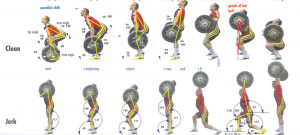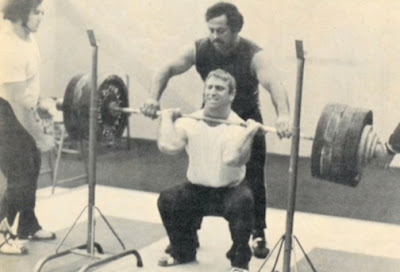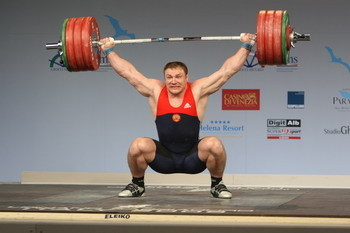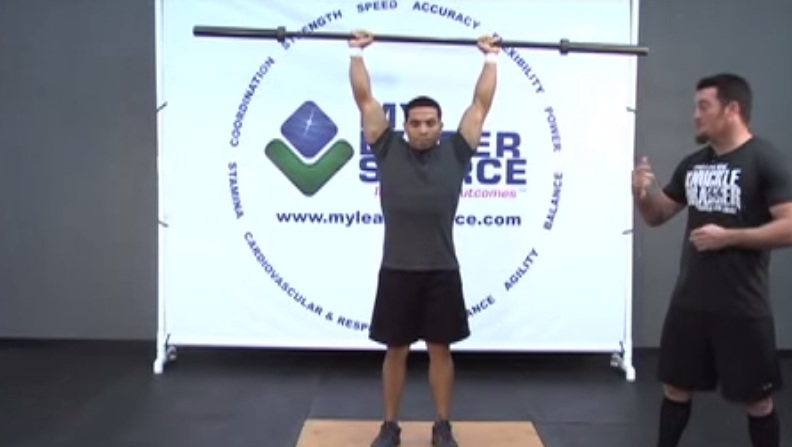Let’s look how to clean and jerk… Clean and Jerk consists of two movements. The clean portion consists of the lifter moving a weighted barbell from the floor to a racked position across deltoids and clavicles. The jerk portion involves lifting the weight above the head until the arms are straight and the bar is stationary.
1. Starting position
The barbell is centered on the platform by the loaders. The lifter approches the bar, standing with feet hip width to shoulder width apart, centered on the barbell. The feet are placed under the bar so the bar is directly over the balls of the feet. Keeping the back straight, the lifer tilts the torso forward slightly, and bending at the knees, lowers into the starting position to grip the bar. The feet are flat on the platform with bodyweight distributed evenly between the balls of the feet and the heels.
2. The first phase of the pull
In the first phase of the pull the bar is raised from the platform in a controlled manner. The knees are straightened so the hips and shoulders raise at the same rate. Once the bar passes the knees, the tilt of the torso is reduced to further raise the bar until it touches mid-thigh. At the same time the torso is brought into a more upright position, the knees re-bend slightly in preparation for the second phase of the pull. The feet remain flat on the platform with bodyweight, and the weight on the bar, shifted back slightly as the bar touches mid-thigh. The arms remain straight thoughout the first phase of the pull.
3. The second phase of the pull
Having completed the first phase of the pull, the lifter is in a power position. From the power position the lifter is ready to enlist the large muscles of the legs, hips and back, in one explosive movement to accelerate the bar. With the knees bent and the torso leaning slightly forward, as if to perform a verticle leap, the second phase of the pull is executed. The legs extend and the hips drive forward forcing the torso upward. The arms are still straight which transfers the movement of the torso to the barbell. The feet, shoulders and arms further assist in lifting the bar. The lifter pushs off the platform with such force that only the balls of the feet and\or toes remain in contact with the platform. In shrugging the trapezious muscles, the shoulders will rise, which, with the addition of some arm pull, will cause the bar to reach its apex.
4. Receiving the bar
Using the arms, the lifter pulls the body under the bar and receives the barbell on the shoulders with the elbows forward of the bar and held high. Depending on the lifters level of skill and/or age, one of two things will happen. The skilled athlete will move into a deep squat position, which does not require the bar be pulled as high, thus allowing a heavier weight to be attempted. The less skilled and/or more mature athlete will bend the knees slightly.
5. Recovery from the clean
The final part of the clean is to stand up and prepare to jerk the bar overhead. If the attempt was a power clean (a slight bending of the knees) the lifter need only straighten the legs and make sure the feet are side by side. From the squating position the lifter keeps the torso as upright as possible and rises using leg and hip strength.
6. Setting for the Jerk
Before attempting to jerk, the lifer may adjust the grip on the bar. A wider grip provides more stability when holding the barbell overhead. The lifter will use the conventional grip for jerking, with the hands relaxed to avoid tightening the forearms. The elbows are held high so the shoulders provide a secure base for driving the bar upward. Feet hip width apart, the lifter stands with the weight of the bar and the body shifted toward the heels. The chest is filled with air and the and the chin is kept in.
7. The Dip and Drive
While maintaining an upright position with the torso, the lifter bends the knees and ankles causing the torso and bar to dip slightly. The lifter then drives upward with the legs to propel the barbell overhead. This movement should be performed with the weight of the bar and the weight of the lifter shifted to the heels. The dip and drive should be performed with quickness. The lifter will drive up on the balls of the feet.
8. The Split
One foot is moved straignt forward and the other is moved straight back when splitting. The forward foot will be flat on the platform while the back foot will have only the ball in contact with the platform. This allows maintaining the upright position of the trunk. The arms push up against the barbell with elbows straight. The knees flex to allow the lifter to sink into the receiving position. The head and trunk are directly under the bar. Should the lifter receive the bar with bent arms and then press until the arms are straight the lift will not pass.
9. Finishing
To recover from the split the lifter moves the forward foot back half the distance of the split. The trailing foot is then moved forward to allow the lifter to have both feet side by side. Holding the barbell overhead and not moving, the lifter waits for the down signal before returning the barbell to the platform.
And cool video how to clean from CaliforniaStrength
and hot to do split jerk from Myleadersource
source of text: http://nvbarbell.com/cjlift.htm




